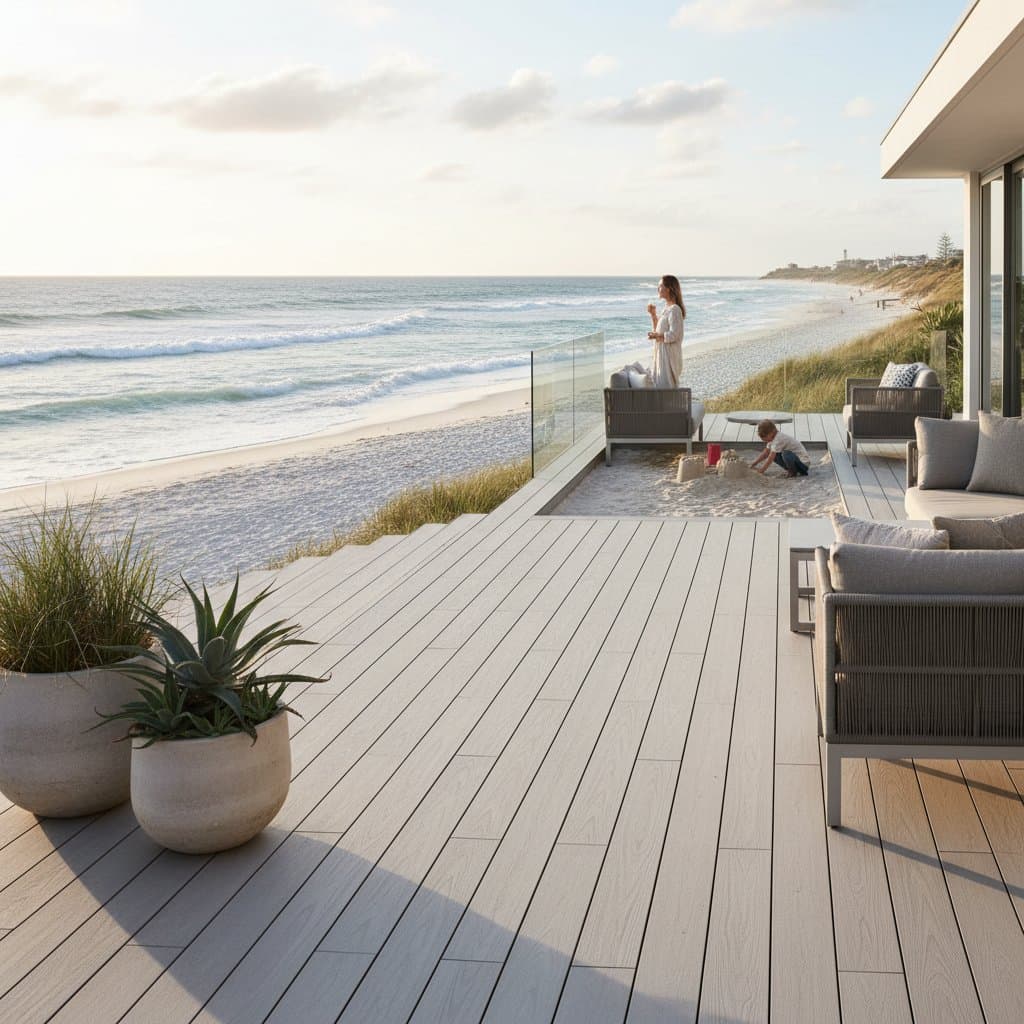Aluminum-Free Decking Defies Coastal Corrosion
Picture yourself enjoying a morning coffee on a sturdy seaside deck, with the ocean breeze carrying a hint of salt, yet the surface below remains pristine, free from rust or deterioration. This scenario is now achievable for coastal residents through innovative aluminum-free decking materials that withstand corrosion and preserve their appeal over time.
Residents near the shore face relentless challenges from saltwater, high humidity, and intense sunlight, which degrade many outdoor structures. Metal decks frequently succumb to rust, and wooden ones often warp or rot under these conditions. Aluminum-free composite decking addresses these concerns effectively, delivering exceptional longevity and requiring little ongoing care.
Key Advantages
- Aluminum-free composite decking outperforms metal alternatives in resisting salt-induced corrosion.
- It integrates recycled plastics with wood fibers to achieve robust construction, aesthetic appeal, and environmental benefits.
- This material suits coastal decks, marina walkways, and beachside patios exceptionally well.
- Maintenance demands stay low when compared to wood or aluminum setups.
- Options include contemporary shades and textures that replicate the look of tropical hardwoods.
- The material offers an extended service life, minimizing the need for repairs or replacements.
Home serves as a sanctuary, particularly when the deck endures the rigors of seaside weather. The following sections delve into how this advanced decking option reshapes waterfront leisure spaces.
Challenges Posed by Coastal Conditions to Deck Materials
The salty air invigorates, yet it exacts a heavy toll on building components. Microscopic salt crystals deposit on surfaces and attract atmospheric moisture, hastening breakdown and rust formation. When paired with strong ultraviolet rays, elevated humidity levels, and persistent winds, these factors create a demanding setting that challenges every element of a deck, from fasteners to surface coatings.
Issues Encountered with Conventional Decking Options
| Material Type | Typical Coastal Challenge | Required Maintenance |
|---|---|---|
| Wood | Rot, mold growth, and color fading | High |
| Aluminum | Rust development and excessive heat retention | Moderate |
| PVC | Deformation and color shifts | Medium |
| Composite (Aluminum-Free) | Slight surface wear only | Low |
Aluminum-free decking avoids these pitfalls through fully encapsulated boards that block moisture penetration. Sustained contact with salt-laden spray results in far less degradation than observed in competing materials, ensuring sustained performance in harsh environments.
To further illustrate, consider how salt accelerates oxidation in metals; aluminum-free composites eliminate metal components entirely, preventing such reactions. Wood fibers within the blend provide natural aesthetics without the vulnerability to biological decay, while plastic encapsulation shields against water ingress. This combination yields a material that maintains structural integrity even after years of exposure to tidal influences.
Approaches to Installation and Opportunities for Customization
Engineers design composite decking for adaptability in various applications. Installers can shape and secure the boards similarly to traditional lumber, enabling intricate configurations like herringbone arrangements, bordered perimeters, or contoured borders.
For those upgrading from deteriorated aluminum or wooden decks, aluminum-free systems typically secure to pre-existing substructures following a thorough evaluation. Verify that the underlying framework supports the composite's load and tolerates marine conditions; professionals often recommend reinforcing joists if necessary to accommodate the material's density.
Creative Concepts Tailored for Seaside Residences
- Driftwood-inspired hues: These shades harmonize with beachside landscapes, fostering an organic integration.
- Expansive board widths: Such dimensions produce a contemporary, uninterrupted vista reminiscent of premium hardwoods.
- Cable-style railings: These features maximize sightlines to the water while upholding essential safety measures.
- Integrated seating elements: Built-in benches optimize spatial efficiency and enhance user comfort.
- Embedded illumination: Subtle lighting solutions prolong usability into nighttime hours, promoting secure navigation.
[Image description: A spacious deck featuring pale gray composite planks paired with minimalist cable railings, with a sandy beach visible in the background.]
Installation best practices include spacing boards slightly to allow for thermal expansion, a common trait in composites exposed to fluctuating temperatures. Hiring certified installers familiar with coastal codes ensures compliance and optimal drainage, which prevents water pooling—a frequent contributor to material stress in humid zones.
Benefits and Drawbacks of Aluminum-Free Decking
| Advantages | Disadvantages |
|---|---|
| Strong resistance to corrosion and dampness | Elevated upfront expense relative to lumber |
| Cooler surface temperatures for comfort | Potential for minor color variation with prolonged exposure |
| Incorporation of sustainable components | Necessity for adequate substructure airflow |
| Authentic replication of wood grains | Few avenues for surface refinishing |
| Reduced need for routine care | Marginally greater weight compared to PVC variants |
Coastal property owners generally find the advantages far surpass the limitations. The diminished maintenance requirements and superior endurance position aluminum-free decking as a prudent long-term choice, often recouping initial investments through avoided repairs.
Expanding on sustainability, many manufacturers source over 90 percent recycled content, reducing landfill contributions and conserving natural resources. This eco-conscious profile appeals to environmentally aware homeowners, aligning outdoor enhancements with broader green living principles.
Maximizing and Sustaining Your Deck Investment
After professional installation, aluminum-free decking elevates everyday outdoor activities. Concerns over rust transferring to furnishings or rough edges injuring skin become obsolete, allowing focus on relaxation and gatherings.
Preservation efforts prove straightforward. Sweep debris regularly to prevent abrasive buildup, and rinse with a mild soap solution annually to remove salt residues. Inspect for loose fasteners biannually, tightening as needed, and ensure vegetation does not encroach on the structure to avoid hidden moisture traps.
For deeper cleaning without compromising the finish, use a soft-bristle brush and avoid high-pressure washers, which might abrade the protective cap. In regions with heavy salt deposition, a freshwater rinse following storms maintains the surface's vitality.
A deck engineered to thrive amid coastal adversities delivers profound contentment, blending visual elegance with unyielding resilience. To embark on this upgrade, research aluminum-free composite decking selections, consult regional contractors for estimates, and construct a platform that endures the ocean's challenges while enriching your lifestyle.

